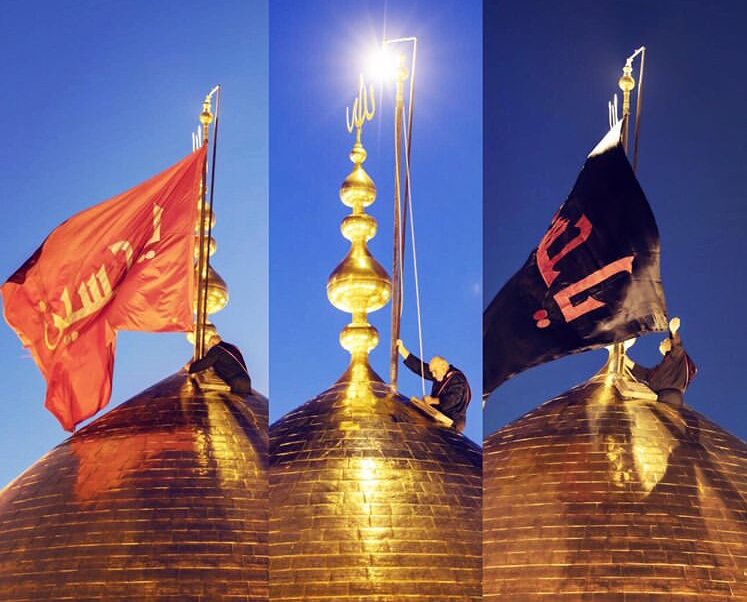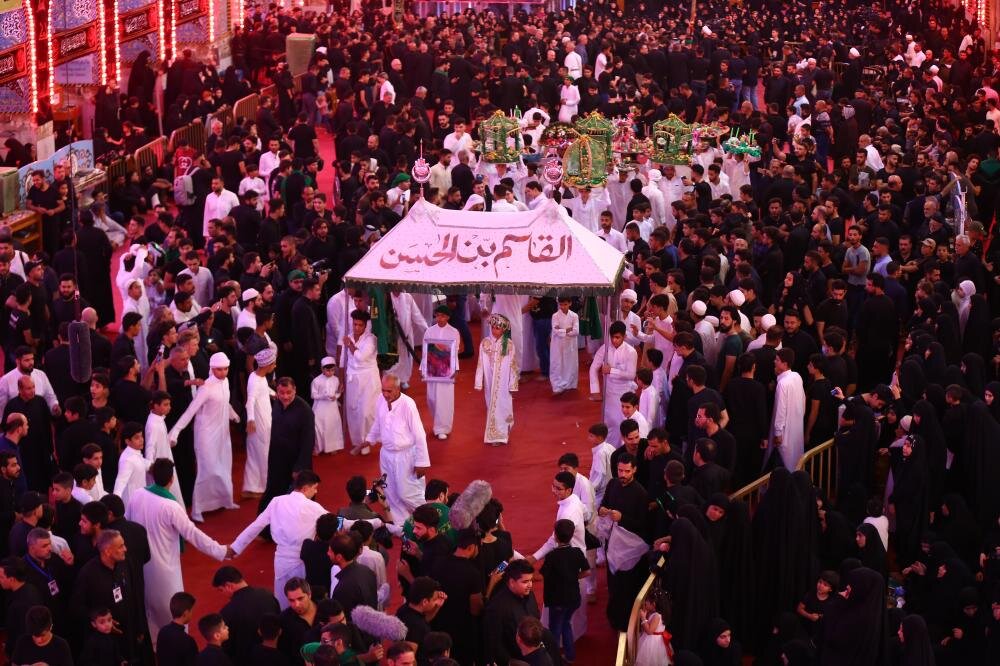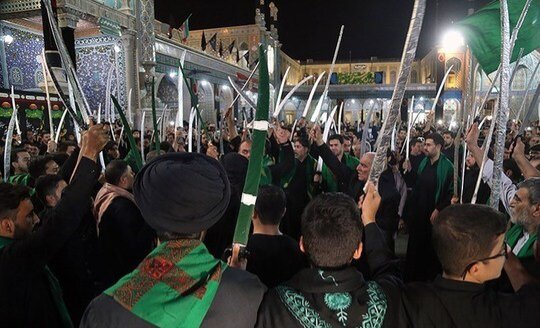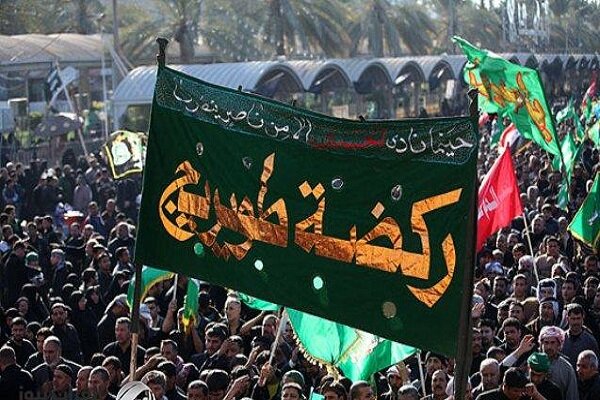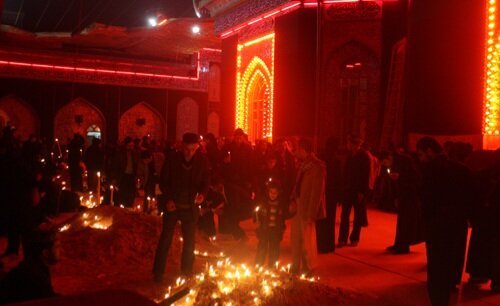Moharram Hosseini’s passion in Iraq; From the ceremony of changing the flag to the “Rakzah Toweerij”
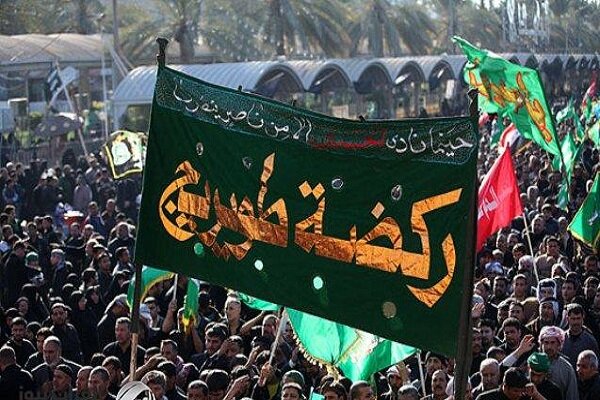
News seal, group Ella, Elnaz Mercy Race : Shiites in Iraq, about 10 days before the beginning of the month of Muharram, by installing flags emblazoned with the name of Imam Hussain (AS) and other martyrs of Karbala on the roofs of houses, alleys and streets, and by covering cities and places of pilgrimage with black. They prepare for the mourning ceremony of the month of Muharram.
The people of this country perform special customs and rituals during Muharram in the city of Karbala.
Holding religious rituals and ceremonies in Iraq has taken various forms during the past centuries and in many cases, it has witnessed the emergence of organized actions. Among the most prominent of these actions, we can mention the ritual of “Rakzah Tuweerij” (running from Tuweerij) and marching on foot to the shrine of Imam Hussain (peace be upon him) in Karbala. In addition, Hosseini mourners express their regret for not helping Imam Hossein (peace be upon him) in Karbala by holding ceremonies.
Millions of Shiites in Iraq and around the world participate in mourning for Hosseini every year in this month. This mourning reaches its peak on the tenth day of the month when the marchers reach the shrine of Imam Hossein (peace be upon him). There, scholars and reciters read poems describing the events of Karbala that led to the martyrdom of Hussein bin Ali (peace be upon him) and his family and companions.
At the same time with the arrival of Muharram 1446, we started introducing mourning habits and customs in the Islamic world.
The first and second part of this report, which is dedicated to mourning habits and customs in Lebanon and Pakistan, can be read and reviewed from the following link:
* “Secret in Lebanon; from ceremony prayer party Allah in Dahiya Ta recitation in Nabatieh”
* “Secret in Pakistan; Fromthe symbolic ceremony “Zul-Janah” to Ship “Ship Salvation”
In the following, we read the detailed third part of this case, which deals with mourning habits and customs in Iraq;
replace flag; from Red to black
The ceremony of the first night of Muharram in Iraq begins with the spiritual ceremony of changing the flag of Imam Hussain (peace be upon him). This special ceremony is accompanied by a large number of mourners. The red flag of the shrine is changed to a black flag to be an official announcement for the start of the mourning ceremony during the two months of Muharram and Safar.
The pillars are also decorated with different candlesticks from the first day of Muharram, which is a symbol of the welcome of the people of Karbala to the caravan of Imam Hussain (peace be upon him) who entered Karbala on this day.
login symbolic Caravan Omar Saad to Karbala
On the second day of Muharram, the Karbala caravan entry ceremony is performed. On the third day, mourning groups from different parts of Iraq enter the city of Karbala and mourn. The most important ceremony of this day is the ceremony of mourning and the symbolic entry of Omar Saad’s caravan to Karbala Ma’ali. Every year on the 3rd day of Muharram, this caravan performs Ta’zih in Karbala in Ma’ali, wearing red and yellow clothes and goes around the two shrines under the title of Omar Saad’s Caravan, reminding the memories of the martyrdom of Seyyed al-Shahda (peace be upon him).
Roz Qasim Ben Alhassan and mourning with Hanna and flower
The people of Iraq, in addition to chanting, mourning, and beating their chests, perform ceremonies with swords, drums, cymbals, and trumpets with special movements that are customary in Arab traditional mourning, symbolically to the call of Hel Man Nasser Yansrani Imam Hussein (peace be upon him). They answer and rush to help him.
Also, on the seventh day of Muharram, which belongs to Hazrat Qasim Ibn Al-Hassan (peace be upon him), they come to the street with henna and flowers and mourn.
Wearing red in mourning processions is a very strange thing, although the majority of people wear black. After the first decade of Muharram, mourning begins and continues for two months.
According to Muharram mourning customs in Iraq, each tribe has a Ta’zia group, and on Friday night every week, a Ta’zi group walks in the streets and performs a piece of the Ashura event for the people.
ritualcarrying the torch
Mashal Gerdani is one of the oldest traditional mourning ceremonies for the people of Najaf, and the participants symbolically prepare to help Sayyed al-Shahda (peace be upon him).
Mashal Darani starts from the eighth night of Muharram and continues until the night of Ashura. In this ceremony, 20 to 40 torches are installed on a long and narrow stick and each torch is lit in the traditional way using thick and woolen cloth and with black oil or diesel. Then the strong or tall people carry this torch on their shoulders and move towards the shrine of Ali bin Abi Talib (peace be upon him).
In front and behind each torch, two people help the torch bearer so that the torch does not fall or anyone gets hurt.
Around each torch, between ten and twenty people with swords in their hands symbolically stomp as if they are preparing for war with the enemies and shout slogans.
In front of each of the torches, a few people are waving long black and red flags with the slogan or Hossein.
Drums and cymbals are important parts of the torch-carrying ritual, and the drums are played in the middle of the mourners with a fast and sharp beat, and they encourage the mourners and the torch-bearers to be more excited.
Sword
Sword exercise is a traditional ritual of mourning for the people of Najaf, according to history, on the night of Ashura, Habib Ibn Mazher Asadi, to appease Zainab (peace be upon her) along with Abbas Ibn Ali (peace be upon him) and the companions who defended the religion And their imam was left, they went to Hossein’s tent.
Habib Ibn Mazhar shouted: “O group of women and shrines of the Messenger of God (PBUH), these are the swords of your young men who have taken an oath not to sheathe unless they strike the enemy’s neck, and these are the spears of your young men who have sworn not to fall to the ground unless they to plunge into the enemy’s chests”.
murder reading; Story Cruelty and oppression Yazid
Muktalet Khani in Karbala and holy shrines in Najaf Ashraf, Kazmin and Samarra are among the most important Muharram special programs. In Iraq, they start reciting Maktal from around 9 am.
In this ceremony, which lasts up to two hours, one of the mourners reads the complete story of the tenth day of Ashura to the mourners, which is accompanied by the burning, grief, and tears of those present at the ceremony.
In Maktaal Khawani, the story of the oppression of the Yazid army and the martyrdom of one by one companions of Aba Abdullah Al-Hussein (peace be upon him) is described, and the end of the massacre leads to the martyrdom of Imam Hussein (peace be upon him).
With the end of Maktal Khwani, the mourners start mourning until the noon call to prayer, and then this ceremony continues with the noon and evening congregational prayers.
After the noon and evening prayers, in a symbolic ritual, the mourners set fire to the symbolic tents of the Ahl al-Bayt (peace be upon them) in the tent area in Karbala, and after that, the ceremony of “Raqza al-Taweerij” (running of the Taweerij) in It begins between the two temples.
ritual Raqqa Taweerij
On the day of Ashura, Iraqi people come to mosques and hosseiniyehs, and one of the clerics recites Muqtal, and people cry over the painful events of that day.
One of the most important groups of mourners who participate in the day of Hosseini’s Ashura in Karbala is the mourning of the well-known village of Taweerij “Hindia”.
Mourning rite known as “Rakzah Tuweerij” (Running from Tuweerij) is one of the biggest human gatherings in the world, which is held every year at noon on the 10th day of the holy month of Muharram to commemorate the martyrdom of Imam Hussain (peace be upon him). /p>
Millions of Hosseini pilgrims from Iraq, Arab countries and foreign countries participate in this ceremony. The participants in this ceremony start their movement from the “Qantara al-Salam” area in Karbala towards the court of Imam Hussein (peace be upon him) in the center of the city and cover a distance of over two kilometers.
Field observations show that the number of participants in this ritual increases every year.
Participants in the Tuweerij rukda ceremony chant the slogan “Labik Ya Hussain” in response to the call of Imam Hossein (peace be upon him) “Hell Man Nasser Yensrani”.
Dinner Strangers in the tent Sometimes
On the 11th night of Muharram or the Evening of the Strangers, people lit candles next to the tent of Imam Hussein (peace be upon him) and accompanied Hazrat Zainab (peace be upon him) and the children of Imam Hussein (peace be upon him) in their sojourn and consoled them. They give.
From the first day of Muharram until the end of Safar every day, the rituals of the 10th day of Muharram end with the end of the Ghariban dinner ceremony, but the mourning rituals continue until the close of the 20th of Safar. It is finished.
All the delegations prepare and distribute all kinds of food, and this reaches its peak in the first decade of Muharram and Arbaeen Hosseini.
Entry Shroud coverhigh Iraqi
During the days of Muharram, the high concentration of Iranian, Pakistani and Indian pilgrims after the Iraqi ones can be seen everywhere in the city of Karbala and in the area of Imam Hussain’s (peace be upon him) shrine.
The presence of Iraqi security forces to ensure the safety of pilgrims is noticeably intensified these days.
Tasua and Ashura ceremonies are held between the two holy places, according to the Iraqi tradition.
Inside the shrines of Imam Hussain (peace be upon him), Hazrat Abbas (peace be upon him) and between the two shrines are decorated with red carpets and are being prepared for the presence of various Iraqi mourning delegations. According to the tradition, many Iraqi mourning delegations enter the hall of the shrines wearing shrouds.
The Iranians do not have an “official” program in these sacred shrines until the 11th day of Muharram due to the special ceremony of the Iraqis, but they accompany the Iraqi Shiites in the mourning ceremonies.
The mourning ceremony of Iranians in the city of Karbala is usually held during the procession of Imam Reza (a.s.) by the delegation of Iran.


